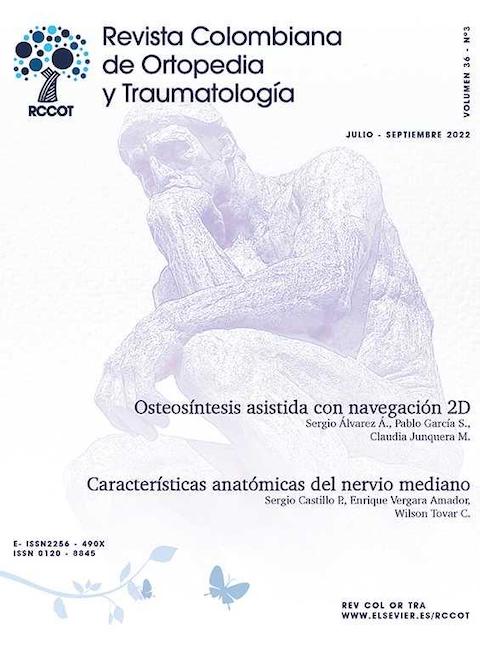Fragility fracture profile in a university hospital
DOI:
https://doi.org/10.1016/j.rccot.2022.07.003Keywords:
osteoporosis, fracture, incidence, distal radius, proximal femur, proximal humerous, spineAbstract
Introduction: About 200 million people in the world has osteoporosis. On average, a frac ture occurs every three seconds and its prevalence has been increasing exponentially in the last decade. Despite being a public health issue in Colombia, we lack statistics that show de magnitude of the disease.
Materials and Methods: It’s a cross-sectional descriptive study with an analytical component in patients with fragility fractures treated in the Emergency Department. The incidence has been calculated and the population characteristics described. We identified statistical significance associations between different variables.
Results: An incidence of 10.7 FF/100 fractures / year and 1.02 FF/100 patients treated at the ED/year was found. There was a higher incidence of fractures at 57 years old, 80% in women, mainly unemployed. Distal radius fracture had a higher prevalence, followed by hip and proximal humerous. 85% of the patients did not had osteoporosis previously. Statistically significant associations were found between age and location, sex and age, and sex and location. Discussion: With population aging, the incidence of FF has been increasing, we found demographic data like those reported in the literature; a higher frequency in women and mainly compromising the distal radius. Due to the methodological limitations of the study, it allows for new questions and hypothesis based on the associations we found. We consider important the identification, diagnosis, and early treatment in these patients since the risk of new falls, associated morbidity and mortality is reduced.
Evidence Level: III: Descriptiveanalytic study.
Downloads
References
Fundación Internacional de Osteoporosis (FIO) | NCD Alliance. 2022. https://ncdalliance.org/es/quiénes-somos/estructura-de-la-alianza-de-ent/grupo-de-apoyo-y-consulta-scg/fundación-internacional-de-osteoporosis-fio.
Johnell O, Kanis JA. An estimate of the worldwide prevalence and disability associated with osteoporotic fractures. Osteoporos Int. 2006;17:1726-33, https://doi.org/10.1007/s00198-006-0172-4
Kanis JA. Assessment of Osteoporosis at the Primary Health Care Level. WHO Collaborating Centre for Metabolic Bone Diseases. University of Sheffield Medical School; Printed by the University of Sheffield. 2008;6:7.
Melton LJ, 3rd, Atkinson EJ, O'Connor MK, O'Fallon WM, Riggs BL. Bone density and fracture risk in men. J Bone Miner Res. 1998;13:1915-23, https://doi.org/10.1359/jbmr.1998.13.12.1915
Melton LJ3rd, Chrischilles EA, Cooper C, Lane AW, Riggs BL. Perspective. How many women have osteoporosis? J Bone Miner Res. 1992;7:1005-10, https://doi.org/10.1002/jbmr.5650070902
Kanis JA, Johnell O, Oden A, Sembo I, Redlund-Johnell I, Dawson A, De Laet C, Jonsson B. Long-term risk of osteoporotic fracture in Malmö. Osteoporos Int. 2000;11:669-74, https://doi.org/10.1007/s001980070064
Lindsay R, Pack S, Li Z. Longitudinal progression of fracture prevalence through a population of postmenopausal women with osteoporosis. Osteoporos Int. 2005;16:306-12, https://doi.org/10.1007/s00198-004-1691-5
THE LATIN AMERICA REGIONAL AUDIT Epidemiología, costos e impacto de la osteoporosis en 2012. 2022. www.iofbonehealth.org.
Ardila E. Epidemiology of osteoporosis in Colombia. Bone. 2001;29:297, https://doi.org/10.1016/S8756-3282(01)00518-X
Carmona F. Osteoporosis en Santa Fe de Bogotá. Instituto Nacional de Salud. Bogotá. 1999.





